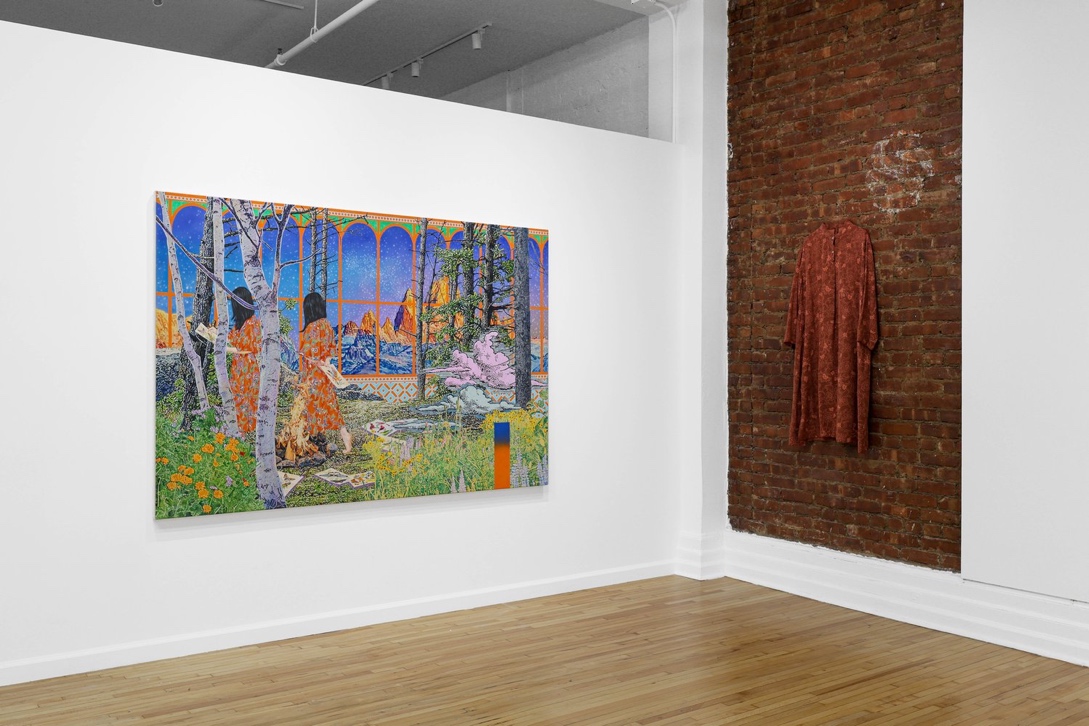
When Naomi Okubo decides to begin working on one of her enthralling paintings, there is a multistep process that far proceeds the brush gracing the canvas. The careful preparation of materials, digital and physical, allow Okubo to consolidate her thoughts and produce an organic depiction of her personal experience. The authenticity with which this is depicted is a result of the forethought and boundless introspection that she imposes upon herself. It is important to note that the artworks selected for the exhibition Naomi Okubo: Resonance on a Surface currently on view at Fou Gallery, weave a narrative fabric that chronologizes Okubo’s development as a visual artist.
Despite an exception or two, most of the works shown were created in 2025. However, a careful review of her previous work makes clear the consistency of her practice, effectively forging a path for her new work to expand upon the artistic identity she has reflected and refracted for almost two decades. There is a tangible and important throughline within this development that it is imperative to identify to best immerse oneself in the exhibition and conceptually digest her work– when a figure is depicted, Okubo does not want you to see their face.
Born in Tokyo, Japan in 1987, Okubo got both her Bachelor of Arts and Master of Fine Arts at the Musashino Art University in Kodaira. Her current and second solo show at Fou Gallery serves as another pivotal moment in her career, showing new works that echo the trusted techniques and forms that she has become so comfortable working within. Okubo’s initial approach to art making lives on through her completed works, by way of both robust emotional expression, and physical collage elements. Her finished canvases often include bright colors and busy patterns that coexist effortlessly, backed by her quiet confidence.

The work Lighting a Flame, 2025 depicts a figure, in the midground, sequentially lighting candles before a caged background. This style of background is a motif commonly used by Okubo, the modern enclosure. In this work specifically, a green house is chosen for the setting of the story. Through this specific setting, Okubo cultivates an intentional and additional weight afforded to the actions and interiors of the composition. The boundless power of a flame being tamed in a controlled environment, the candle sticks at various points in their waxed lifecycles, and a figure guiding their match towards the unknown; these individual elements homogenize and emanate a subtle sense of uncertainty. The unease evoked by Okubo’s works has become a staple of her practice, and something that lives in one’s psyche well beyond the time one spent in front of the canvas.

The complexity of Okubo’s layering and pattern use culminates with her work Bird Collector, 2025. In one of her most recent works done in this style, the sheer multiplicity of visual stimuli prevents you from looking away. Situated within an ornately decorated room, nearly every surface in the background brandishes more than one geometrical pattern. As the eye navigates the architectural geometry of the canvas, like a city grid, the depth becomes unnerving as inconsistencies in layering reveals itself to the viewer. The circular green windowpanes serve as unreliable narrators, disorienting the positionality of the leaves and cultivating palpable tension given the incongruity of their orientation. The papers on the wall host fold lines that only sometimes align with the cells on the wallpaper they are perched on. These examples serve to amplify the unrest stirred, as elements of the painting reveal themselves to you only once your eyes have traced the outline of every shape, figure, or animal. Pillows blend into dresses, chairs into walls, and birds into backgrounds. Okubo’s ability to utilize multiple mediums for storytelling in a single 57 x 44 in. canvas is remarkable and implies that we are only being served a meager ration of what she is capable of.

A true testament to style blending and innovation comes with Okubo’s decision to create and wear the same dress worn by the figures in her painting Canary Cave, 2025. By wearing it at the opening of her most recent show at Fou, she was able to attend as one of the figures she so frequently portrays in her artwork. Having stated that the women she paints serve predominantly as self-portraits, attending in this dress strikes the perfect balance between her artwork and its relation to her lived experience. Okubo embraces the sentiment that your outward appearance and style of dress greatly affect how others perceive you, and this performance proves it. The conceptual nature of this work stands out in comparison to Okubo’s oeuvre and can be interpreted as strides in a new creative direction. The intentionality of her decision making is emblematic of someone constantly improving, and it is an exciting prospect that she may still have ground to break just around the corner.
Naomi Okubo: Resonance on a Surface
Curated by Lu Solano
Fou Gallery
89 Fifth Ave, Suite 701, New York, NY, 10003
June 7 – July 27, 2025
Tuesday – Sunday, 11 AM – 6 PM. Other times by appointment.
About the writer: Rory Martin is a detail-oriented and research-focused writer from Boston, currently based in New York. He earned an MA in Contemporary Art from Sotheby’s Institute of Art, and has experience in art administration, writing, and archival research for prestigious galleries and museums. Rory has written for small art publications and is an admirer of all kinds of art but truly loves compositions of significant abstract nature. With a passion for pop culture and its movements, writing about art is a platform he often utilizes to help track these major shifts.